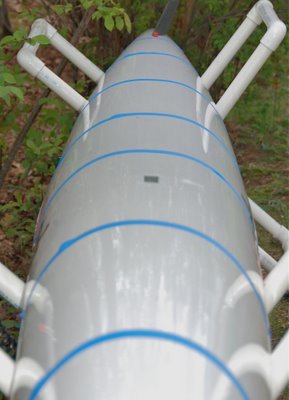Review: Epic V12 Ultra
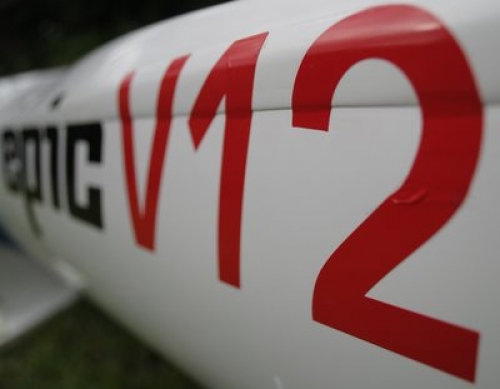 Epic V12
Epic V12
I have had the opportunity to spend some time with an Epic V12 this spring. The following is a review of that ski plus additional uninvited and personally biased commentary.
The Basics
The Ultra construction V12 that I have is awfully light. I don’t have an accurate scale, but the advertised 23 lbs seems about right. Boat construction is not my forte’ so I won’t comment much about that. In short, though, it seems light, stiff, well finished, typical of the Epics. The outer skin, according to Greg Barton, is a “combination of carbon (in the higher stress areas) and Kevlar on the outside, and Kevlar and lightweight fiberglass on the inside” with a core mat in between. Because I’m a “run the boat up onto the beach” and a “Rock? That’s merely a speed bump!” type of guy, my preference would be more in line with a solid hull that would be less susceptible to pressure point impacts, even if it would add a pound or two.


Footwell
The footwell size and shape seems standard and in line with the Fenn Elite and the Think Uno. The footplate is angled back a normal amount. It’s easy to adjust. The rudder cables are Spectra and continuous as a loop, so you can adjust the footwell length without the use of an allen wrench, which to me, is neither here nor there as it’s easy to do on the Fenns anyway. I don’t like that the V12‘s footplate creaks a bit when you really “stomp on the gas”, but any two-point anchored footplate will creak to a certain extent. I think only the Stellar and Red7 skis have the 3-point footplates, though I could be wrong about that.
V12 Seat
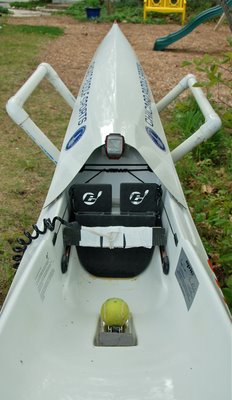
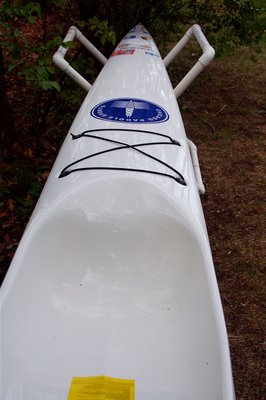
The V12‘s seat is “the bomb” [Editor: For our non-US readers, this is “good”]. In my opinion, the V12 and the Think skis have really hit the seat shape and under-knee hump perfectly. Having said that, I am fully aware that everyone’s backside is a different size and shape and that no one ski will be perfect for every paddler. But, after having spent many hours in many skis, and having overheard many other paddlers’ similar comments regarding the Think and V12 seats, I feel fairly comfortable generalizing there. Specifically, the V12 seat is wide and flat at the bottom so you’re less likely to get “hip pinch” if you’ve got wide hips. The standard V10, V10L, Fenn Elite, Mako 6, original Synergy have seats that are lower and more rounded and thus more likely to result in “hip pinch”. “Why not “just add a foam pad?” In my experience, that’s never as good an option as if the seat were simply raised and flattened and paddled bare (bare seat, not bare paddler).
Cowling
I suppose that I should comment on the V12‘s cowling because it’s kind of innovative for a racing ski. I don’t really have an opinion about it, though. I do use it but I chopped it a bit so that its “arms” won’t get in the way of my paddle when I do a reentry. I also drilled a hole in it to attach a gps because I don’t think that the gps will get reception under the cowling and I prefer not having the gps on the footstrap.
Venturi
The V12 venturi is an Andersen SuperMini bailer, common on small boats like sailboats and open canoes. When open, it sucks air at 5 mph (9 kph). I have closed the venturi, filled the footwell entirely, opened the bailer, and watched it drain while paddling in rough water. It drains well and the footwell stays completely dry while paddling. One opens and closes the bailer with a wire handle that’s simple to use in a open style canoe or a sailboat. I, however, found it quite troublesome to open or close when on the water. I don’t know if it’s my short arms or fat legs, but it’s practically a Yoga position to get my hand down to that bailer handle. I also practically come to a complete stop attempting to open or close it, and I almost capsize each time I try. So why incorporate a bailer that a fat old guy like me can’t open or close while paddling? Well, I thought about this, and came up with a new and improved handle design that is easier to operate and you can operate it with your foot.
New improved venturi handle
The pictures are likely all you’ll need, but just in case, here’s how I made it. Drill / burn a slot in one side of the tennis ball just wide enough to fit the top of the cage into (I used a Dremel tool with a drill bit). Drill two smaller slots on the other side of the tennis ball, one in front of and the other behind where the cage top hits the inside top of the ball. Through those latter two slots, insert a long zip tie through one and out the other, making sure to “grab” the cage. Tighten the zip tie and rotate it so that the cut end is inside the ball where it won’t cut your foot.

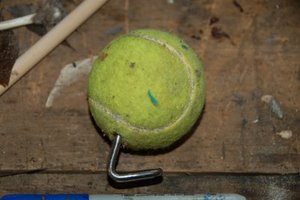


Then cement some sort of “stopper” astern of the bailer so that the ball doesn’t “flop” backwards too far. You can now close the bailer by rolling the ball forwards with your heel, and open it by rolling the ball back and down to open it. I can now open or close the bailer even while paddling rough water or while surfing.


Just don’t take your dog’s ball like I did, or you’ll have one frustrated dog.
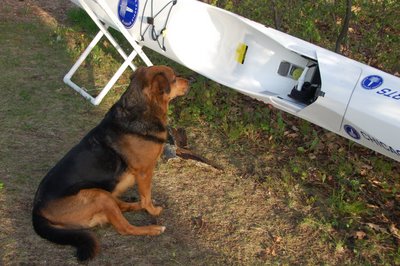
Hey dad, what did you do with my ball?
Speed
I have done several interval sessions on the V12, and I think that I have a pretty good idea of its speed. Firstly, the boat speed that I think relevant for most of us is the steady state marathon race pace speed, i.e. about 7.2 to 8.2 mph (13.3 to 15.1 kph). I’ve done many of these sessions in a variety of skis with a gps and HRM. Usually, I’ll do several back to back 2 km intervals with 1 min rest in between, on flat, deep water, and I’ll average about 7.5-8.0 mph (13.9 to 14.8 kph). To me, the V12 with bailer all the way open seems be a bit slower than the Uno and Fenn elite, but with the bailer closed, might be a hair faster than either on very flat water. Paddling with the bailer all the way open increases the drag noticeably - and my guess is a drop in speed of about 0.1 to 0.2 mph (0.2 to 0.4 kph) at my interval speed. That’s on flat water. On rough water, the drag from the bailer probably matters considerably less.
Handling
How does the ski paddle? Well, I think you can tell a lot just by looking at the hull shape and how it’s different from other elite racing skis. Below the waterline, the V12 looks pretty standard with a narrow rounded cross section, no chines, and no flat spots, so, it should feel fairly predictable on the water and like it has low drag and somewhat low initial stability - and it does. Where the V12 is different from the other elite racing skis, though, is that from the waterline up, it flares considerably from the bow to the stern. So, secondary stability is actually pretty good and very predictable. As a result, the V12 feels quite stable in waves because the waves “hold” onto the wider waterline beam higher up on the ski and they do this at the bow, amidships, and at the stern. In beam waves, it performs well, too, and because its bow has a rounded cross-section like the new Red7 and Uno, it doesn’t get rolled and pushed much by the wind and waves.
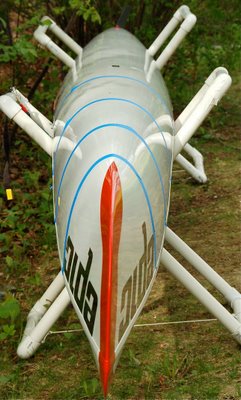
Downwind
Downwind, I think the bow flare works well and gives the ski a really stable and soft, floating feel much like the Custom Kayaks Mark 1 which I think is like a magic carpet ride. I’ve had the V12 on a few downwind runs, one of them a 22 mile (41 km) straight shot in 3-5 ft (1-2 m) seas. The V12 steers very neutrally and seems to lift or stay on top of the runners as opposed to porpoising up and down, digging in to the waves, or feeling too loose or squirrelly. The cockpit placement must be a bit forwards on the ski because the V12 seems to drop down and into runners fairly easily, surprising me occasionally. The Fenn Elite has that same tendency. Initially, I though the steering on waves to be a bit sluggish. I speculate that this is because of the interaction of the slightly flexible rudder pedals, the Spectra lines, and the spacing on the rudder yoke. If you simply use a bit more rudder pedal movement, however, to steer the boat, then you’re fine and it becomes a non-issue.
At first, I was burying the bow quite a bit while surfing. I then learned that the V12 responds very well to slightly leaning back to get the bow up and running on top of the wave, so in the end, I don’t see it as an issue for me where I paddle.
Rudders
I’ve used the standard Epic rudder, the new weedless Epic rudder, and two custom rudders, one quite small and raked at 45 degrees, made by Don Kiesling (DK) from Seattle. All seem to work well with the ski, even the small DK one, which tells me that the hull’s stability is mainly from its shape and not from the rudder.

DK rudder for the Epic V12
The yoke that holds the rudder in place seems solid and practical and works well enough for me to not be worried about the rudder coming loose or falling off. But, in my opinion, the simplicity of the Fenn’s hex-nut on top of the square-top rudder post or the adjustable Think system are better and more fool-proof.
Pluses
- comfort - great seat, footwell
- good secondary stability.
- great speed
- ability to close / “draw in” the venturi bailer to lower drag
- easy reentry
- standard easily adjustable footstrap
Minuses
- footplate is a bit creaky against the footwell bottom (easily addressed by contact cementing vinyl or rubber to the bottom of the footwell)
- carbon shaft rudder, which, for no particular reason, I just don’t trust. (I believe Epic is changing these to SS shaft, though)
- While not an industry standard, it would be nice to see integrated bow and stern handles or "through-holes" and an integrated leash attachment point.
Comparisons and Comments
Last year, I trained and raced on a Kevlar layup Think Uno, the year before that I trained and raced on a carbon Fenn Elite, and a carbon Mako 6 was before that. To establish my reference points, I have also owned or spent a considerable amount of time in the following: an Icon, Mark 1, Fenn XT, Synergy, V10, and a millenium. I think the closest comparison I could make would be that the V12 feels similar to a Mako 6 in its overall feel, but the V12 has better ergonomics and better flatwater glide / speed, lower gunwales, and tracks better.
Unlike the Fenn Elite, the Think Uno, and the Fenn millenium, the V12 has good secondary stability spread throughout its length (I have not spent enough time in an Ultra layup V10 or V10L to accurately compare those two to the Ultra layup V12). I define secondary stability here as what is the ski’s tendency when you lean it over onto it’s side? Does it feel stable like that / like it wants to right itself? Or, does the ski feel like it’s on a knife-edge when it’s leaned over and like it could tip either way? This (secondary stability from bow to stern) comes into play, for instance, if you’ve landed a bit cockeyed onto your bow having just crested a wave. The V12’s wider bow will pop you upright somewhat or hold you there long enough to get a good brace stroke in. This design trait may come at a price, though, and if I were a betting man, I’d bet that the V12 may be just a hair slower than the Uno and Elite in some rough water conditions due to its greater above waterline beam. This is assuming that there are zero, zilch, nada stability issues in the other skis, though.
Both the Think Uno and the Fenn Elite are great skis and the only troubles that I had paddling either were in my head, i.e. I just didn’t get comfortable enough in either when the wind waves approached or exceeded about 4-6 ft (2 m) in height. Call it a strong self-preservation gene, if you like. And, most of us have this to some extent. It’s subconscious, mostly. For a ski paddler, I would say that oftentimes it’s the risk of a capsize combined with the probability of a quick and uneventful recovery. Unlike other things, this gene gets larger as we get older and even larger if we have families to support. Mine is pretty big, too, but I don’t really want to brag about it, obviously. You don’t want this (personal safety) to be at the forefront of your mind when paddling because it will make you more tense, slow you down, and make the paddle less enjoyable.
Safety
As an aside, the main reason why many of us paddle a ski is because they are inherently safer than paddling a kayak with an open cockpit. And in my opinion, ski designs should be “dumbed down” so that they’re not only easy for 90% of paddlers to do a reentry 90% of the time, but for 100% of paddlers 100% of the time. Elite paddlers rarely get into trouble with reentries, but the reality is that intermediate paddlers buy the elite skis, too, and many of us paddle in cold water where we don’t have that many chances for a successful remount before we start to get into exposure-related difficulties. The V12 and Red 7 Surf 70 Pro are easy to remount, more like the SLS spec skis. I hope that this is a trend that we will see more of in the future.
The Most Overrated and Underrated Ski in the Solar System
According to Joe Glickman's Dubai quiz, Oscar says that the V12 is the fastest ski in the solar system. That’s probably open for debate. From the looks of it though, the V12 might not have lived up to its original promo of being the fastest ski in the solar system - a fact which is propagated by the choice of some Epic team paddlers who choose to race the V10 even if they can fit in the V12. But, to me, the V12 is the perfect sub-elite level paddler’s ski, too. It should therefore appeal to a wider audience than a pure elite ski would. Like the Huki S1X’s, the V12 gives the paddler the extra volume and stability on rough water that they need - or that they think they need. To be clear, it's not an "all conditions" ski for an intermediate ski paddler, but it does provide more room for error for those paddlers who may feel a bit timid in rough water in other elite level skis. It’s low gunwales make remounting it fairly easy, and its flatwater speed is as good as any other ski out there - with the bailer in the closed position.
Just the other day, I went out in the early evening on a downwind run of a few miles. I was alone, it was dusk, I was about 1 km offshore and the water temp was about 52 F (12 C). The waves were only about 2-3 ft (1 m), but in the V12, I felt more stable and relaxed than I have felt in another ski in a long time. To me, that’s what’s important. If I feel relaxed in the ski, then I’m having fun. And for the first time, I’m finding myself oftentimes paddling “Aussie style”, aka without a pfd on, and not really worrying about it. Gads.


